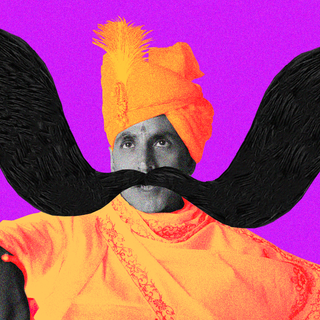
Overrated, Not: Rajinikanth
What makes Rajinikanth’s image unassailable is his bombastic, over-the-top persona and films that allow one to suspend their disbelief.

In ‘Overrated, Not,’ we revisit things that were so good, they quickly turned bad, and make a case for why they deserve a comeback.
In the mythology of Rajinikanth, there is very little left to say. Entire reams of pages have been dedicated to a man who, for many, is a god walking on Earth. There are all the trappings of a hero’s journey in his story: beginning from his humble origins in Maharashtra as a bus conductor, ending with his inimitable name, dialogues, and moves eliciting euphoria across the country. There is nothing quite like witnessing a Rajinikanth film “FDFS” — first day, first show — where the “Super Star Rajni” title card and iconic music prompt a frenzy of deafening cheering, hooting, whistling, and dancing among the more enthused.
And yet, a complicated legacy endures. This is not least due to the fact that in Tamil cinema, the lines between fantasy and reality blur to a degree that idolized stars use their screen personas as a pipeline into politics. In the beginning, Rajinikanth built himself up on the screen as someone with “mass” appeal; in opposition to his contemporary, Kamal Hassan, who is associated with “class” films. The iconic hand gestures, the knowing sneer, the cigarette, and later, sun-glasses tossing are all hallmarks of a man whose legend dwarfs that of most people’s. What made Rajinikanth’s image unassailable is his bombastic, over-the-top persona; his films are replete with generous pay-offs for audiences wishing to suspend their disbelief for a few hours at the movies.
In the popular imaginary, however, the man was reduced to something of a caricature. It was when his superstardom became known beyond the reaches of the south that the stereotyping and crude humor began: the genre of “Rajinikanth jokes” sat at an uncomfortable line between loving homage and derisive mockery. “He is the very end of analysis,” wrote author Manu Joseph once, adding that Rajinikanth is “the hero of semi-literates” and a “beloved clown.” Besides the obvious elitism and classism, Joseph’s words echo widely held sentiments about Rajinikanth: that he is one for “the masses,” and therefore, not one whose name is compatible with taste or elan.
Related on The Swaddle:
Overrated, Not: One‑Hit Wonders
And soon enough, upper-crust snobbery masked as critique descended swiftly upon the star’s oeuvre; trashing his every film, dialogue, and move as regressive, unsophisticated, and crude. This, notwithstanding the fact that Amitabh Bachchan’s rise to stardom was from the same genre of “mass” films. The difference in their respective treatments, however, is that Rajinikanth came from humble beginnings, and Bachchan came from storied ancestry already.
The grouse against Rajinikanth, then, seems to be that you cannot take him seriously. That, unlike the more serious films of his contemporaries either in the South or beyond, Rajinikanth is not just unserious. He is silly.
This put-down, in particular, had the effect of denuding his aura. But this assessment completely misses the fact that the magic of Rajinikanth is in the suspension of disbelief, the larger-than-life iconography, and the vision of what it would look like for working-class dreams to come true: the everyman who can, and does, evolve into a hero. Even so, Rajinikanth’s role in Chandramukhi (2005) signified a marriage of “class” and “mass” — retaining the signatures of the icon while transposing him into a different context than we are used to seeing him in. As scholar S.V. Srinivas puts it, his character in the film represented “the ‘death’ of Rajinikanth characters, if only to disavow that possibility.” In reinventing not only himself but genre and form, he has opened up possibilities in cinema and popular culture that kept the wheel turning, even against ridicule and discrediting.
In recent years, moreover, Rajinikanth moved into slightly different territory — thanks to directors like Pa Ranjith. His detractors, and even some fans, had words for this too: he became formulaic, staid, and boring. But there aren’t too many others of his stature who appear in three-piece suits in front of a portrait of Ambedkar, playing a Dalit character who resolutely asserts his identity. Far from being an abject recipient of violence, he plays a hero emblematic of Malcom X, Che Guevara, and revolutionaries whose images frequently appear onscreen.
The thing, however, that makes Rajinikanth endure is that he is also infallible. In the last decade, many have noted his internal tussle between holding on to his youthful antics, or playing characters his own age. Here is a living legend in turbulence with his own image; irrespective of the box office, however, the cheers at the title card remain as resounding as ever.
And even for someone whose mythos exceeds his personal failings, very little is equal to his delivery in Kabali (2016), for instance, telling the antagonist why he wears a suit, with his trademark sneer to boot. All set against a background score of riffing electric guitars, these moments are what his movies are all about. They represent not only stories, but aspirations. In simply remaining loyal to the power of storytelling, Rajinikanth has fortified the cultural legacy of the movies, turning it from a simple watching experience to a veritable ritual which people forge meanings with.
If Rajinikanth has taught us anything about dreams, it’s that they can and often, do, come true.
Rohitha Naraharisetty is a Senior Associate Editor at The Swaddle. She writes about the intersection of gender, caste, social movements, and pop culture. She can be found on Instagram at @rohitha_97 or on Twitter at @romimacaronii.
Related


The Buzz Cut: Self‑Appointed National Hero Requests Next Film Be Compulsory School Viewing
